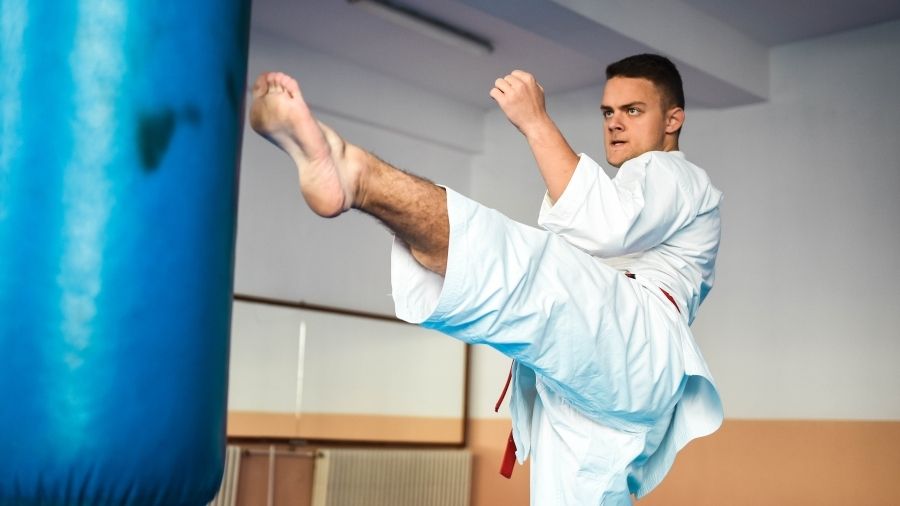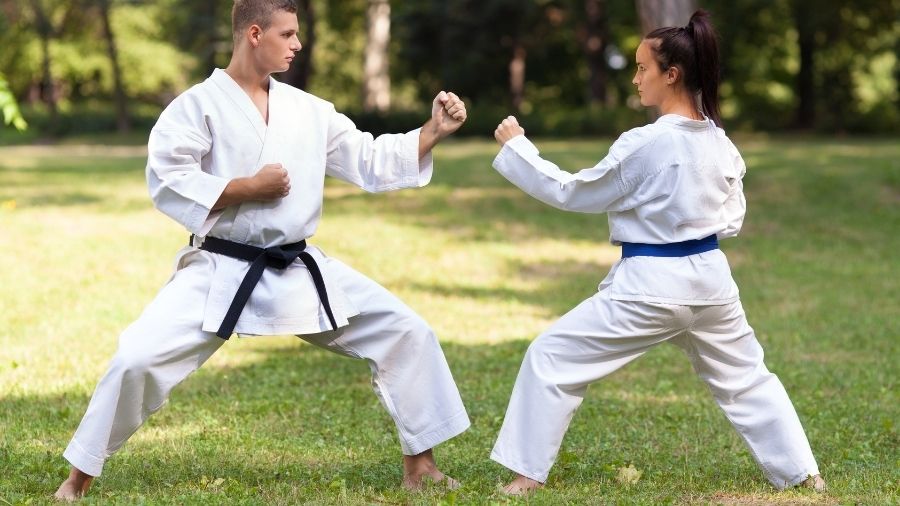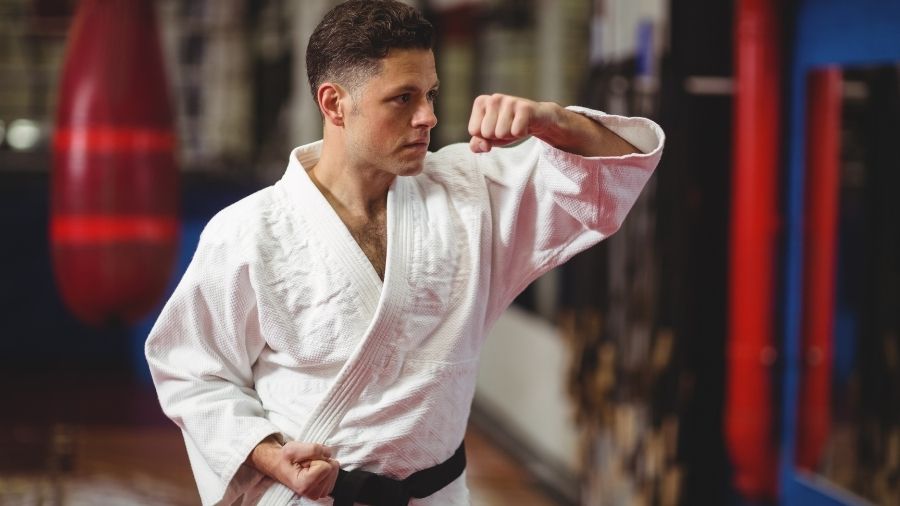The discussion of which martial art is best for self-defense is endless. It has only intensified in the age of social media. One of the main participants in these debates is the Japanese martial art of karate, and the short answer to the question is karate good for self-defense is yes.
Karate was initially created for self-defense if trained and used as originally intended. There are many techniques, moves, and mental skills taught in karate that will help you be successful in a real-life self-defense situation.
However, this statement is valid only if you train and use karate the traditional way. Today, many styles have evolved into a sport with very specific rulesets that are unsuitable for real fights and can be detrimental.
Another thing you must understand before we continue is that there are different styles of karate that come from the same foundation but have vastly different approaches. So we can’t just view karate as a single entity and determine its effectiveness for self-defense.
Is Karate Effective In A Real Fight?

Karate was (and still is) in certain schools, a method to develop the body and the spirit while acquiring skills and tools to defend yourself unarmed. When taught this way, karate focuses on mental strength and self-discipline, including devastating techniques aimed at the fastest possible neutralizing of an aggressive opponent.
Discover The Little Known Secrets For Unlocking Devastating KO Power!
Heavy hands are built doing these things...
Making traditional karate very effective in a real fight. The problem comes with modern sport karate. As seen in the latest Olympics, sport karate has nothing in common with traditional karate.
Like other combat sports, a specific rule set prohibits many techniques in favor of safety. The rules score favorably for some techniques over others, leading to a game that revolves around winning more points.
Most karate styles take this further and prohibit hard strikes altogether and award only precision. While this is not necessarily bad for sports, learning to punch inches from the opponent is completely different from hitting to hurt him. And in a real-life situation, this will most likely get you badly hurt.
The world of combat sports and the competitive aspect of traditional martial arts cross at many points. But some glaring differences that you must always consider if you plan on using your martial arts skills in self-defense. If you want to have skills transferable to the real world, you must train accordingly.
Awareness may be the most crucial skill in self-defense. Karate teaches amazing reaction and situational awareness, which will help you greatly against violent attackers in any situation.
What Karate Techniques Are Effective In A Real Fight?

Original karate is self-defense. So pretty much all techniques are oriented towards success in an altercation. The primary objective in such a situation is to avoid injuries and protect your loved ones. And specific techniques will help you do that better than others (although everything is dependent on the situation).
Let’s take a look at some effective techniques commonly used in karate.
Straight Punches
Straight punch blitzes are very common in sports karate and are one of the few things that are good for real fights. Storming your opponent with crisp straight shots while advancing at great speed will surprise almost anyone.
Open Palm Strikes
Punching a skull as hard as you can with a bare hand will almost inevitably result in an injury to the hand. Palm strikes were invented for this very reason, and they are a safe and effective alternative to punches. All karate styles have palm strikes (not in their sports versions, of course).
Elbows and Knees
The elbows and the knees are very hard and sharp bones and are the perfect weapons in close combat.
Straight and Swinging Punch Defense
Most blocks trained in karate kihon (technique) are exaggerated. Still, they are very effective if you keep only the core part of the movement. If you train the blocks to be used effectively against real punches, they can indeed work in a real fight.
Groin Strike
There are no rules in real combat, and kicking the groin is a very effective tactic. Unlike combat sport disciplines, karate has a groin kick in its arsenal, and it’s intended to paralyze your attacker with one strike.
I can continue listing techniques for a very long time. Most traditional karate is designed for self-defense, so it should work as intended. On top of that, different karate styles have different approaches and techniques. We can’t easily separate what is effective like we can with kickboxing self-defense.
The most important part of the equation is not the technique but how you train them. Effectiveness is directly linked to the way you train. The only way to really prepare for a real fight is to train against fully resisting and uncooperative partners and to spar regularly. Only then will you develop the physical and mental qualities required to use the moves when you most need them.
What Styles Of Karate Are Good For Self Defense?

Modern karate originated from Okinawa in the late 19th century. It was named and formed as an official martial arts style in the 1930s. Shortly after, dozens of different karate styles emerged from the root.
Next, we will look at the main styles of karate and how they handle self-defense. It must be that schools in the same style may have very different focuses. One may concentrate on sports competitions, while others may prioritize self-defense.
If you want to learn traditional karate for your personal protection, first research the schools before choosing. Now let’s look at the most popular karate styles and their self-defense applications
Shotokan
By far, the most popular style of karate is Shotokan. It came from Tokyo and was established by the founder of modern karate, Master Gichin Funakoshi. The original concept of Funakoshi for his art is self-defense. If appropriately taught, it will help you in the street.
But the modern sport ruleset is the exact opposite. While it’s a noble sporting and spiritual pursuit, it can even be detrimental for self-defense.
Goju Ryu
Another of the original Goju Ryu karate is focused on short-range combat. It has very efficient close-range strikes and blocks. As opposed to the long and linear movements of Shotokan, Goju Ryu may be better suited for a real-life altercation.
The art also employs a lot of grappling, sweeping, and breaking different locks. The regular body conditioning done in Goju Ryu will toughen the body and prepare it for the realities of combat.
Wado Ryu
Wado Ruy focuses more on the soft sides of karate. It aims to avoid incoming attacks and use circular motions rather than blocking or meeting them with force. Wado Ruy also shies away from hard sparring and body conditioning, making it the least applicable to real-life combat.
Kyokushin
Kyokushin came a bit later than the original Okinawan styles, but it’s one of today’s most popular styles. The techniques are challenging, and the stances are natural and much more practical. Out of the other basic styles, Kyokushin is the only style referred to as “knockdown” karate, which means it’s full contact.
Although punches to the head are not allowed, strikes with feet are. Regardless of the target, you can deliver all strikes with full force, and a knockdown is the main purpose, not just scoring points. Kyokushin practitioners become fighters who know how to take and deliver a punch.
Karate Disadvantages And How To Make It Work?
Different karate styles have various disadvantages. But we can safely say that usually, sport karate goes against good self-defense practices. As predominantly striking arts, most karate styles lack deep knowledge of grappling.
Still, then again, traditional karate was developed to train you for protection against attackers, not combat, versus another skilled martial artist.
So while you may be doomed in a grappling match against a judoka or BJJ practitioner, the grappling aspects of karate should give you the upper hand in a real-life scenario.
Always analyze the moves you learn and think about how they can be applied. Identify problematic points in a possible real-life situation and think about how to resolve them. Then train these situations and scenarios with fully resisting partners and see how it goes. Regularly spar and condition your body to deliver and endure impact.
In the age of MMA, a few successful karatekas managed to transfer their skills to the most demanding stage. Probably the most successful of them all is Lyoto Machida.
He and his brother Chinzo managed better than anyone to transform karate into a modern-day effective combat system while keeping traditional karate’s fundamental philosophical, mental, and spiritual principles.
Summary
Answering is karate good for self-defense is much more complicated than dissecting other styles. Karate has too many schools, styles, rulesets, and variables that make them almost different arts altogether. But if trained as it was initially intended with real-life application, karate is a great martial art for self-defense.


